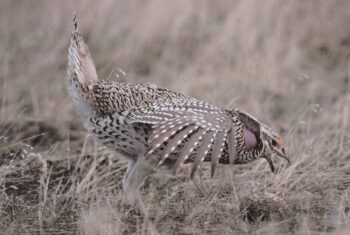Scout Clean Energy Launches Prairie Grouse Habitat and Population Study
FOR IMMEDIATE RELEASE
CONTACT: Chad Thompson
901-331-0779
Scout Clean Energy Launches Prairie Grouse Habitat and Population Study
Forges unique partnership with South Dakota Game Fish & Parks to Benefit Conservation Efforts
Boulder, CO – June 30, 2021 – Scout Clean Energy (“Scout”), a Colorado based renewable energy developer, owner, and operator, is partnering with the South Dakota Game Fish and Parks (SDGFP) and Western EcoSystems Technology, Inc. (WEST) on a comprehensive sharp-tailed grouse research study, enabling greater understanding of the effects of wind farm siting, construction, and operations on the local sharp-tailed grouse population.
“The overall goal of this research study is to determine if a wind farm may have any effects on sharp-tailed grouse habitat use, survival and reproduction,” explained Michael Rucker, CEO of Scout. “The study is the first of its kind and will be important for developers to better understand the bird’s daily activities.”
The study will occur over a three-year period including one year of pre-construction and two years of post-construction at the project. SDGFP and WEST will lead this research effort with funding support from SDGFP and Scout. The State Wildlife Grant allows the state to apply for federal assistance to study species habitat.
“As a non-regulatory agency, we often collaborate with energy developers to help better understand the impacts of siting these utility projects,” said Travis Runia, SDGFP upland game biologist. “The key to our partnership with Scout is that it allows us to leverage our funding support to get 2 to 1 federal matching funds.”
Results from this study will add to the growing body of scientific literature that investigates the effects of wind energy development on grouse species to provide managers with science-based management recommendations to inform siting of future wind energy projects. This research presents a unique opportunity in the United States where the potential effects of wind energy construction and operations on grouse populations can be investigated.
The study will use telemetry to capture grouse activity around the turbines. The scientist mount GPS transmitters on the birds using a harness. The transmitters weigh less than three percent (3%) of the bird’s body weight.
“An interesting component of the study is the use of GPS telemetry,” said Kurt Smith a research biologist with WEST. “With the GPS transmitters we are able to capture locations every 15 minutes to track their activity around the wind turbines. This data will be invaluable as we study if there are changes in their movements before and after construction.”
Scout Clean Energy is developing the Sweetland wind energy facility which will be located in Hand County, South Dakota. It will include up to 71 wind turbines with a phased 2021/2022 construction schedule with commercial operations scheduled in 4Q-2022. The presence of sharp-tailed grouse within and near the project provide a valuable opportunity to evaluate the potential effects of wind energy development on the local sharp-tailed grouse population.
Scout has more 5,000 MW in its active project development pipeline across wind, solar PV, and battery storage spanning all major US markets and an operational portfolio of onshore wind energy generation of 1,235 MWs with projects in PJM, CAISO, ERCOT and SPP.


